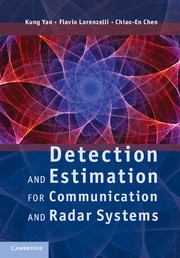Book contents
- Frontmatter
- Dedication
- Contents
- Preface
- 1 Introduction and motivation to detection and estimation
- 2 Review of probability and random processes
- 3 Hypothesis testing
- 4 Detection of known binary deterministic signals in Gaussian noises
- 5 M-ary detection and classification of deterministic signals
- 6 Non-coherent detection in communication and radar systems
- 7 Parameter estimation
- 8 Analytical and simulation methods for system performance analysis
- Index
5 - M-ary detection and classification of deterministic signals
Published online by Cambridge University Press: 05 July 2013
- Frontmatter
- Dedication
- Contents
- Preface
- 1 Introduction and motivation to detection and estimation
- 2 Review of probability and random processes
- 3 Hypothesis testing
- 4 Detection of known binary deterministic signals in Gaussian noises
- 5 M-ary detection and classification of deterministic signals
- 6 Non-coherent detection in communication and radar systems
- 7 Parameter estimation
- 8 Analytical and simulation methods for system performance analysis
- Index
Summary
In Chapter 4, we considered the detection of known binary deterministic signals in Gaussian noises. In this chapter, we consider the detection and classification of M-ary deterministic signals. In Section 5.1, we introduce the problem of detecting M given signal waveforms in AWGN. Section 5.2 introduces the Gram–Schmidt orthonormalization method to obtain a set of N orthonormal signal vectors or waveforms from a set of N linearly independent signal vectors or waveforms. These orthonormal vectors or signal waveforms are used as a basis for representing M-ary signal vectors or waveforms in their detection. Section 5.3 treats the detection of M-ary given signals in AWGN. Optimum decisions under the Bayes criterion, the minimum probability of error criterion, the maximum a posteriori criterion, and the minimum distance decision rule are considered. Simple minimum distance signal vector geometry concepts are used to evaluate symbol error probabilities of various commonly encountered M-ary modulations including binary frequency-shifted-keying (BFSK), binary phase-shifted-keying (BPSK), quadra phase-shifted-keying (QPSK), and quadra-amplitude-modulation (QAM) communication systems. Section 5.4 considers optimum signal design for M-ary systems. Section 5.5 introduces linearly and non-linearly separable and support vector machine (SVM) concepts used in classification of M deterministic pattern vectors. A brief conclusion is given in Section 5.6. Some general comments are given in Section 5.7. References and homework problems are given at the end of this chapter.
- Type
- Chapter
- Information
- Detection and Estimation for Communication and Radar Systems , pp. 149 - 189Publisher: Cambridge University PressPrint publication year: 2013



